Index:
- Phosphorus (P)
- Potassium (K)
- K fertilization requirements, timing and methods
- Effects of N, P and K on rice yield
- Secondary plant nutrients
- Micronutrients (trace elements)
- Zinc (Zn)
- Boron (B)
- Iron (Fe)
- Manganese (Mn) toxicity of rice
- Aluminum (Al) toxicity of rice
2.1 Chemical properties of flooded soils
Since rice is predominantly grown under wetland conditions, it is important to understand the unique properties of flooded soils for better management of fertilizers for this crop. When a soil is flooded, the following major chemical and electrochemical changes take place:
a) Depletion of molecular oxygen
b) Chemical reduction of soil
c) Increase in pH of acid soils and decrease in pH of calcareous and sodic soils
d) Increase in specific conductance
e) Reduction of Fe3+ to Fe2+ and Mn4+ to Mn2+
f) Reduction of NO3- to NO2-, N2 and N2O
g) Reduction of SO42- to S2-
h) Increase in supply and availability of N, P, Si and Mo
i) Decrease in concentrations of water-soluble Zn and Cu
j) Generation of CO2, methane and toxic reduction products, such as: organic acids and hydrogen sulphide
These will have a profound influence on soil nutrient transformations and availability to rice plants.
2.2 Patterns in symptomology of nutrients deficiency symptoms in rice
Influence of nutrient mobility on symptomolgy:
Mobile Nutrients:
- Nitrogen
- Phosphorus
- Potassium
- Magnesium
Deficiency symptoms appear in oldest (lower) leaves first, because their mobile nutrients contents move to the youngest leaves, which act as sinks.
Immobile Nutrients:
- Calcium
- Iron
- Manganese
- Zinc
- Sulfur
Deficiency symptoms appear in youngest (upper) leaves first, because these nutrients become part of the plant compounds.
2.3 Nitrogen
Nitrogen increases plant height, panicle number, leaf size, spikelet number, and number of filled spikelets, which largely determine the yield capacity of a rice plant. Panicle number is largely influenced by the number of tillers that develop during the vegetative stage. Spikelet number and number of filled spikelets are largely determined in the reproductive stage.
Farmers use split applications for N. The number and rate of application can be varied. Ability to adjust number and rate allow the synchronization to real time demand by the crop. Leaf color charts allow farmers to estimate nitrogen demand of the crop by comparing the leaf color to the chart (Figure 2.1).

Figure 2.1: Leaf color chart
The initial symptom of nitrogen deficiency in rice is a general light green to yellow color of the plant. It is first expressed in the older leaves because nitrogen is translocated within the plant from the older leaves to the younger ones. Prolonged nitrogen deficiency causes severe plant stunting, reduced tillering (Figure 2.2) and yield reduction (Figure 2.3).
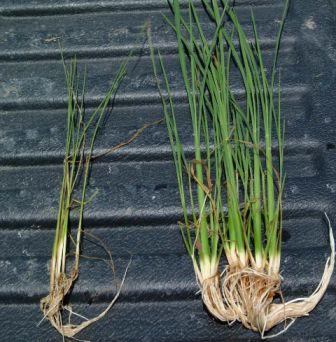
Figure 2.2: Nitrogen-deficient plant (left) versus a well-fed plant of same age (right)
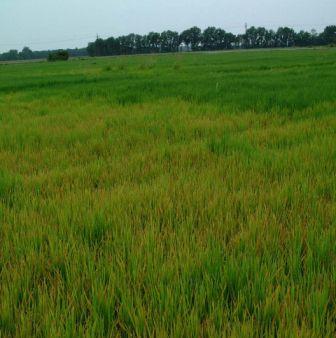
Figure 2.3: Pale green color indicates N deficiency
2.3.1 Nitrate-nitrogen (NO3–) promotes uptake of ammoniacal-nitrogen (NH4+)
Nitrogen (N) is one of the essential macronutrients for rice growth and one of the main factors to be considered for developing a high-yielding rice cultivar. In a flooded paddy field, ammonium (NH4+) rather than nitrate (NO3–) tends to beconsidered the main source of N for rice. However, in recent years, researchers have paid more and more attention to the partial NO3– nutrition of rice crops, and their results have shown that lowland rice was exceptionally efficient in absorbing NO3– formed by nitrification in the rhizosphere. The NO3– uptake rate could be comparable with that of NH4+, and it could amount to one-third of the total N absorbed by rice plants. Therefore, although the predominant species of mineral N in bulk soil for paddy rice fields is likely to be NH4+, rice roots are actually exposed to a mixed N supply in the rhizosphere. The growth and N acquisition of rice is significantly improved by the addition of NO3– to nutrition solution with NH4+ alone. The increased N acquisition could be attributed to the increased influx of NH4+ by NO3–.
2.3.2 Fertilizer N-use efficiency
In lowland rice losses of applied N take place through: a) ammonia volatilization, b) denitrification, c) leaching, and d) runoff. The recovery of fertilizer N applied to rice seldom exceeds 30-40 %. Fertilizer N use efficiency in lowland rice may be maximized through a better timing of application to coincide with the stages of peak requirement of the crop, and placement of N fertilizer in the soil. Other possibilities are the use of controlled-release N fertilizer, e.g. Multicote™ and CoteN™ and the exploitation of varietal differences in N efficiency utilization.
In the anaerobic environment of lowland rice soils, the only stable mineral form of N is NH4+. Nitrate (NO3-) forms of N, if applied, will enter the anaerobic zone and be subjected to heavy denitrification losses. At planting time, the base-dressing of N should never be supplied as nitrate. For topdressing the growing plants, however, NH4+ and NO3- forms may be used with almost equal efficiency. Fully established rice can rapidly take up applied NO3- before it is leached down to the anaerobic soil layer and can become denitrified.
2.3.3 Early N application and management
The early N application (65 to 100 percent of the total N rate) should be applied as an ammonium N (NH4+) source onto dry soil, immediately prior to flooding at around the 4- to 5-leaf growth stage (Table 2.1). There is not an exact time to apply early N, but actually a window of a couple of weeks that the early N can be applied. Once the early N is applied, flooding should be completed as quickly as possible, preferably within five days of the N application. The flood incorporates the N fertilizer into the soil where it is protected against losses via ammonia volatilization and/or nitrification/denitrification as long as a flood is maintained. The flood should be maintained for at least three weeks to achieve maximum uptake of the early applied N (Table 2.2).
Table 2.1: Effect of pre-flood nitrogen application timing, and soil moisture on rice grain yields
|
Time before flood (days) |
Soil moisture |
Uptake of applied N |
N Use Efficiency* (%) |
Grain Yield |
||
|
Pounds/A |
kg/ha |
bu/A |
kg/ha |
|||
|
10 |
dry |
85 |
95 |
71 |
124 |
6255 |
|
10 |
mud |
46 |
52 |
42 |
102 |
5145 |
|
5 |
dry |
100 |
112 |
82 |
129 |
6507 |
|
5 |
mud |
71 |
80 |
59 |
105 |
5296 |
|
0 |
dry |
107 |
120 |
83 |
132 |
6659 |
|
0 |
mud |
68 |
76 |
64 |
111 |
5599 |
|
0 |
flooded |
37 |
41 |
31 |
75 |
3783 |
* 130 kg/ha of N applied at the 4- to 5-leaf stage.
Source: Norman, et al., 1992. p. 55-57. Ark. Soil Fertility Studies 1991. Ark. Ag. Exp. Sta. Res. Ser. 421
Table 2.2: Percent Nitrogen Uptake by Rice Crop at Different Times after N Application
|
N Application Timing |
Sampling Period, days after application |
% N Plant Uptake |
|
Preflood: Urea applied on a dry soil surface and flooded immediately |
7 |
11 |
|
14 |
27 |
|
|
21 |
63 |
|
|
28 |
65 |
|
|
Midseason: Urea applied into the flood |
3 |
70 |
|
7 |
67 |
|
|
10 |
76 |
Source: Wilson, et al., 1989. SSSAJ 53:1884-1887
2.3.4 Pre-flood application or split applications?
In order to answer this question, results of a field trial from Missouri, US, are supporting split applications although inconclusive results whether one or two split applications should be applied, as presented in Table 2.3. All treatments received a total N of 170 kg/ha. The first treatment, which had the recommended nitrogen application, yielded 6,003 kg/ha (119 Bu/acre). The second treatment, which only had one midseason application, yielded 6,053 kg/ha (120 Bu/acre). The third treatment yielded 5,953 kg/ha (118 Bu/acre). The treatment that received 67 kg/ha (=60 lbs/acre) of N, only yielded 5,549 kg/ha (110 Bu/acre) and the treatment that received 168 kg N/ha (150 lbs. N/acre), all at pre-flood, yielded 5,398 kg/ha (107 Bu/acre).
Table 2.3: Nitrogen timing applications*
|
Preflood |
Midseason |
One week after midseason |
Yield |
||||
|
(lbs/A) |
kg/ha |
(lbs/A) |
kg/ha |
(lbs/A) |
kg/ha |
(Bu/A) |
kg/ha |
|
90 |
100 |
30 |
34 |
30 |
34 |
119 |
6,003 |
|
90 |
100 |
60 |
67 |
0 |
0 |
120 |
6,053 |
|
105 |
118 |
45 |
50 |
0 |
0 |
118 |
5,953 |
|
60 |
67 |
45 |
50 |
45 |
50 |
110 |
5,549 |
|
150 |
168 |
0 |
0 |
0 |
0 |
107 |
5,398 |
The rice produced in a dry-seeded, delayed flood cultural system in which the permanent flood is not established until the rice is 15 to 20 cm tall, optimum N fertilizer use efficiency has been achieved by applying at least 50% of the total N immediately prior to permanent flood establishment, and the remaining N applied within the interval beginning with internode movement to 10 days after internode movement of 1.2 cm.
Some new cultivars produce yields that are comparable, and sometimes greater, when a single pre-flood application is made as opposed to a two- or three-way split of the total applied N. Rate and timing of N are critical in terms of their effect on yield.
2.3.5 When is N application required?
Nitrogen is the most limiting nutrient for rice production in many countries. Unlike plant nutrients such as P, K, and zinc (Zn), no suitable soil test method has been established and implemented for determining the N-supplying capacity for soils used to produce rice.
Rice plants require N during the tillering stage to ensure a sufficient number of panicles. The critical time at active tillering for N application is typically about midway between 14 days after transplanting (DAT) or 21 days after sowing (DAS) and panicle initiation.
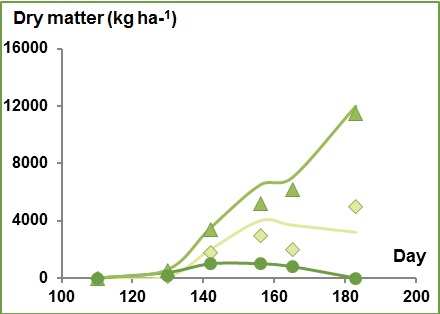
Figure 2.4: Observed biomass (lines) of total above ground dry matter (), green leaves (●), and stems (®),Rain fed IR64 Jakenan, Indonesia, 1995
At panicle initiation (about 60 days before harvest of tropical rice), it is critical that the supply of N and K are sufficient to match the needs of the crop. Insufficient N at panicle initiation can result in loss of yield and profit through reduced number of spikelets per panicle. Insufficient K supply at panicle initiation can result in loss of yield and profit through reduced spikelets per panicle and reduced grain filling.
2.4 Yield response to N fertilization
An experiment (Bollich and Linscombe) regarding timing of N application has shown the clear superiority of preplant N application as shown in Table 2.4.
Table 2.4: Yield response to time of N application in water-seeded flooded cypress rice
|
Method/Timing* |
Grain Yield** (kg/ha) |
|
Preplant |
7,548 |
|
Pre-flood |
6,124 |
|
Post-flood |
5,778 |
* 100 kg/ha of N applied in each treatment
** Yields are three-year average
The least N losses due to leaching or volatilization took place when the only application was closer to the flooding time (Table 2.5).
Table 2.5: Rice yield response to time of N application in dry-seeded rice
|
N Timing |
Yield (kg/ha) |
Yield Loss (%) |
|
9 days pre-flood |
7,415 |
8 |
|
6 days pre-flood |
7,525 |
7 |
|
3 days pre-flood |
7,559 |
6 |
|
0 days pre-flood |
8,117 |
– |
|
3 days post-flood |
6,484 |
21 |
|
6 days post-flood |
6,140 |
24 |
Nitrogen fertilization improves yields. Field trials responses are 28.4 and 18.9 kg rice per kg N for 25 and 50 kg/ha rates, respectively (Table 2.6). Yield increase is affected by variety, soil N supply capacity, amount of radiation during the reproductive phase, and management practices such as weed control and plant density.
Table 2.6: Mean yield response to N fertilization, Entre Ríos
|
Varieties |
N rate |
Mean N response |
|
|
kg/ha |
Rice yield (kg/ha) |
kg of rice / kg N applied |
|
|
San Miguel INTA |
25 |
453 |
18.1 |
|
50 |
550 |
11.0 |
|
|
El Paso 144 |
25 |
540 |
21.6 |
|
50 |
870 |
17.4 |
|
|
Don Juan INTA |
25 |
710 |
28.4 |
|
50 |
779 |
15.6 |
|
|
IRGA 417 |
25 |
632 |
25.3 |
|
50 |
946 |
18.9 |
|
Table 2.7 gives the recommended N rate and application timing for the most commonly grown rice varieties in the Mississippi Delta. These recommendations were derived from numerous on-farm tests conducted on various soil types. Lodging can be reduced by applying 50% of the total N prior to establishing the permanent flood and splitting the remaining 50% into two midseason applications. For varieties that are not sensitive to lodging, two-thirds of the total N should be applied prior the permanent flood and it is not necessary to split the remaining one-third at midseason. More information about reducing lodging rate is given in the chapter dealing with potassium nutrition, see Figure 2.16, following.
Table 2.7: Nitrogen recommendations by cultivar and soil type
Source: Rice fertilization - Mississippi Agricultural & Forestry Experiment Station, 2003
|
Cultivar |
Clay soils |
Silt loam soils |
||||||
|
Total |
Pre-flood |
Midseason |
Total |
Pre-flood |
Midseason |
|||
|
First |
Second |
First |
Second |
|||||
|
|
(kg/ha) |
(kg/ha) |
||||||
|
Cocodrie |
200 |
135 |
67 |
– |
179 |
129 |
50 |
– |
|
CL-121 |
200 |
135 |
67 |
– |
179 |
129 |
50 |
– |
|
CL-141 |
200 |
100 |
50 |
50 |
179 |
90 |
45 |
45 |
|
CL-161 |
200 |
135 |
67 |
|
179 |
118 |
50 |
|
|
Francis |
200 |
100 |
50 |
50 |
179 |
90 |
45 |
45 |
|
Priscilla |
200 |
135 |
67 |
|
179 |
129 |
50 |
|
|
Wells |
200 |
100 |
50 |
50 |
179 |
90 |
45 |
45 |
|
XL7 |
200 |
135 |
67 |
– |
168 |
100 |
67 |
– |
|
XL8 |
200 |
135 |
67 |
– |
168 |
100 |
67 |
– |
|
CL-XL8 |
200 |
135 |
67 |
– |
168 |
100 |
67 |
– |
As Baldo (an Italian variety) is very sensitive to over fertilization, special attention must be paid to the management of this crop. A study was conducted to determine the effect of different pre-flood nitrogen rates on lodging and yield of Baldo rice. At nitrogen rates less than 110 kg/ha lodging was 3% and lower. At nitrogen rates at 135-170 kg/ha lodging increased significantly and respectively from 39% to 82%.
For each treatment there were varying rates of pre-flood nitrogen applied and 35 kg N/ha applied at mid-season on all treatments. As Figure 2.5 indicates an increase in nitrogen up to 135 kg N/ha caused yields to increase. When applied nitrogen levels were higher than 100 kg/ha though, lodging increased significantly.
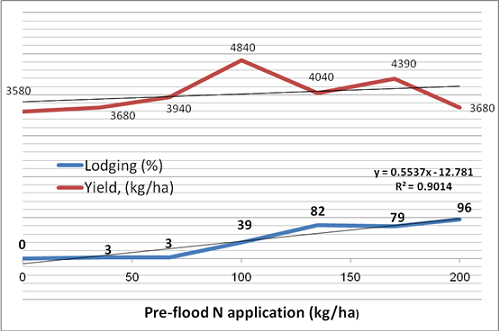
Figure 2.5: Effect of pre-flood nitrogen rates on grain yield and plants lodging.All treatments received mid-season N applications at the same time (35 kg/ha of N).
Source: Effects of Nitrogen on Baldo Rice, University of Missouri-Delta Center
2.5 Time and method of nitrogen fertilization in water-seeded rice
Urea is generally the N fertilizer of choice.
Most of the nitrogen fertilizer should be applied pre-flood and pre-plant in water-seeded rice if the soil is not allowed to dry during the growing season. Nitrogen fertilizer should be placed either on dry soil and flooded in immediately or shallow incorporated and flooded within 3-5 days.
If several days elapse between the period of nitrogen application in ammoniacal form and flooding, much of the nitrogen will convert to nitrate. When the soil is flooded, nitrate is broken down by bacteria and released to the atmosphere as a gas, a denitrification process.
Denitrification losses can be avoided by flooding soils within 3-5 days after nitrogen application. These losses are greatest when nitrogen is applied into water on young rice. When most of the nitrogen is applied preplant, rice fields should not be drained, or drained only temporarily. In this situation, if a field must be drained during the growing season, the field should not be allowed to dry out before re-flooding. The field should be maintained in a saturated condition to protect the pre-plant nitrogen.
From internode elongation (green ring) through the beginning of head formation, nitrogen must be available in sufficient quantity to promote the maximum number of grains. Nitrogen deficiency at this time reduces the number of potential grains (florets) and limits yield potential.
Sufficient nitrogen should be applied pre-plant or pre-flood to assure that the rice plant needs no additional nitrogen until the panicle initiation (green ring) or the panicle differentiation (2 mm panicle) stage. When additional nitrogen is required, it should be topdressed at either of these plant stages or whenever nitrogen deficiency symptoms appear.
2.5.1 Second crop fertilization
Ratoon or second crop rice should be fertilized with 50-85 kg/ha of nitrogen, when first crop harvest is before mid-summer. When first crop harvest is after mid-summer, fertilize with 35-50 kg/ha of nitrogen. Higher rate of nitrogen should be applied when conditions appear favorable for good second crop production (minimal field rutting, little or no red rice, healthy stubble).
2.5.2 Recommended N rates
Nitrogen rates range 70-200 kg/ha (60–180 lbs/acre) depending upon variety and soil history.
N applied in a 2 or 3-way split: first time just before flooding, then again at about 1 cm internode elongation.
The early N application (65-100 % of the total N rate) should be applied as an ammonium N source onto dry soil immediately prior to flooding at around the 4- to 5-leaf growth stage. The University of Missouri recommendations for nitrogen are variety specific. Table 2.8 gives the nitrogen recommendations for 4 popular varieties.
Table 2.8: Nitrogen recommendations for 4 rice varieties (kg/ha)
|
Variety |
Total N |
Preflood |
Mid-season |
|
Cypress |
168 |
101 |
34+34 |
|
Drew |
151 |
84 |
34+34 |
|
Lamont |
202 |
135 |
34+34 |
|
Cocdrie |
168 |
101 |
34+34 |
Table 2.9: Nitrogen recommendations by variety
|
Variety |
N Rate* (kg/ha) |
|
Gulfmont, Lemont, Dellrose, Dixiebelle, Jefferson |
110-185 |
|
Cypress, Bengal, Cocodrie, Jodon, Lafitte, Riscilla, Wells |
110-170 |
|
Drew, Maybelle, Toro-2, Jackson, LaGrue, Madison |
110-160 |
|
Mars, Jasmine 85 |
90-135 |
|
Rico 1, Della, S102 |
80-110 |
|
Saturn, Dellmati |
70-100 |
*Usually only 20-50 kg/ha are required if the earlier nitrogen application was sufficient. If nitrogen deficiencies are observed prior to these growth stages, apply nitrogen topdressing immediately. Early nitrogen deficiency may greatly reduce yields.
Based on the site-specific nutrient management (SSNM) approach for fertilization of rice (IRRI 2006), a rice crop requires about 50 kg/ha of N fertilizer for each ton in additional grain yield. The optimal amount of fertilizer N required to attain the yield targets of 5.5 MT/ha in the dry season and 6.5 MT/ha in the wet season. This amount of fertilizer N can be split into three applications with an early N application of about 20 to 30 % of the total requirement. The remaining 70 to 80% is split into two applications based on the need of the rice crop, as determined from leaf color using the leaf color chart (Figure 2.1).
Table 2.10: General guidelines for efficient N management in rice
|
Situation |
Strategy |
|
Upland (dryland) |
Broadcast and mix basal dressing in top 5 cm of surface soil. Incorporate top-dressed fertilizer by hoeing-in between plant rows and then apply light irrigation, if available |
|
Rainfed deep water |
Apply full amount as basal dressing |
|
Lowland (submerged) |
Use non-nitrate sources for basal dressing |
|
Soil very poor in N |
Give relatively more N at planting |
|
Assured water supply |
Can topdress every 3 weeks up to panicle initiation. Drain field before topdressing and reflood two days later |
|
Permeable soils |
Emphasis on increasing number of split applications |
|
Short duration varieties |
More basal N and early topdressing preferred |
|
Long duration varieties |
Increased number of topdressing |
|
Colder growing season |
Less basal N and more as topdressing |
|
Over aged seedlings used |
More N at planting |
High-pH soil conditions increase N volatility when urea (46-0-0) is used as the N-source.
The source of N can increase N efficiency under certain situations. On newly precision-leveled fields, or on low-organic-matter soils, ammonium sulfate (21-0-0-S24) may offer a yield benefit when compared with urea. Ammonium sulfate is also less volatile on high-pH soils compared with urea.
2.6 Phosphorus (P)
2.6.1 The role of P in rice
Proper phosphorus (P) nutrition is critical for producing maximum rice grain yields. Phosphorus is very important in the early vegetative growth stages. Phosphorus promotes strong early plant growth and development of a strong root system. It is important to rice plants because it promotes tillering, root development, early flowering, and ripening.
Often P deficiency in rice is referred to as a "hidden hunger" because the symptoms are not apparent unless P-deficient plants are directly compared with plants that have sufficient P. When compared with healthy rice of the same age, P-deficient rice is characterized by an abnormal bluish green color of the foliage with poor tillering and plants that are slow to canopy and slow to mature. When plant comparisons are not available, plant tissue testing is the best tool for diagnosis of P deficiency.
Rice plants that are deficient in P are stunted and dirty-dark green, and they have erect leaves, relatively few tillers, and decreased root mass.
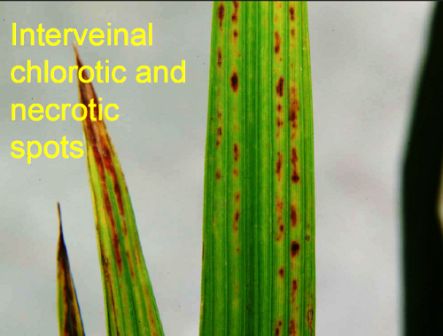
Figure 2.6: Phosphorus deficiency
2.6.2 The effect of soil pH on P availability
Phosphorus (P) fertilizer recommendations for rice are currently based on soil testing for available P and soil pH. Phosphorus availability to rice is optimum when the pH is below 6.5.
For upland crops, P availability is usually optimal when the soil pH is between 6.0 and 6.5.
In acid soils (pH 6.0), the P is associated (“tied up” or “fixed”) with iron and aluminum compounds that are slowly available to most plants. In acid soils, P availability increases following establishment of the permanent flood due to the chemical changes that occur to the iron phosphate. Thus, more P is available for rice following the flood than is measured with routine soil test methods.
In soil where pH is greater than 6.5, the P is primarily associated with calcium and magnesium. Not all calcium and magnesium phosphate compounds are slowly available to plants since their availability declines as pH increases. As a result, P is usually not limiting on acidic soils. In contrast, the availability of calcium phosphates tends to be low and remains low after flood establishment in alkaline soils (pH > 6.5).
Under Flooded Conditions:
- P is released to the soil solution as Fe3+-phosphate compounds, which become reduced and convert to Fe2+-phosphate compounds under low oxygen conditions
- On soils low in active Fe or low in total P, sufficient P may not become available
- On high pH soils (>7.0 ), with an abundance of calcium (Ca), the Ca-phosphate compounds may not release adequate P to the soil solution.
Research has shown that soil pH is a better predictor of rice response to P fertilization than soil test P. However, soil pH is not static and can vary by as much as 1 pH unit, depending on sample time, environmental conditions and other factors. Application of P fertilizer to undisturbed acid soils that test low in P has failed to show significant yield increases and in some cases has increased lodging, caused rank vegetative growth and/or decreased yield.
Flooding rice soils generally moderates the pH towards a neutral pH condition, thus promoting the availability of soil P.
Figure 2.7: Rice yield response to P on clayey soils in Mississippi
In cases, when soil P content is less than 8 ppm, a yield response is not associated with soil P content. When soils are flooded, reducing conditions mobilize P from ferric iron (Fe3+) and aluminum (Al) phosphates to more labile forms and increases P mineralization from soil organic matter, both acting to satisfy the crop’s P requirement.
Table 2.11: P recommendations based on Olsen P in soil tests and target yields
|
|
Olsen P in soil tests |
||
|
10 |
20 |
30 |
|
|
Target yield (t/ha) |
Phosphorus application P2O5(kg/ha) |
||
|
4.5 |
52 |
32 |
16 |
|
5.0 |
62 |
42 |
26 |
Source: Perumal Rani et al., 1985
Factors like soil texture, P fertility status, seasonal conditions and duration of the variety are often taken into consideration (Table 2.12).
Table 2.12: Recommended rates of P for wet rice production
|
Available P (Bray I) |
P2O5 rate, (kg/ha) |
||
|
ppm |
Rating |
1st crop |
2nd crop |
|
0- 4 |
Very low |
70-80 |
50-60 |
|
5-10 |
Low |
60-70 |
40-50 |
|
11-20 |
Medium |
40-60 |
20-40 |
|
21-50 |
High |
20-40 |
0-30 |
|
Over 50 |
Very high |
0-30 |
0-20 |
Source: Lian, 1989 (Taiwan)
2.7 P deficiency symptoms
Phosphorus fertilizer should be applied only when recommended by soil test results or when deficiency has been diagnosed.
Visual symptoms of P deficiency may not be present in yield-limiting cases. Tissue test whole plants at the preflood stage to ensure that adequate P is available to rice plants. Tissue levels should be at least 0.18 percent P to ensure maximum yields.
Phosphorus (P) deficiency symptoms normally appear in the lower part of the plant and results in: (1) decreased leaf number, (2) decreased leaf blade length, (3) reduced panicles/plant, (4) reduced seeds per panicle, and (5) reduced filled seeds/panicle. The reduced tillering capacity for rice planted in a P impoverished soil is usually greatest factor responsible for reduced yields.
Normal / Deficient
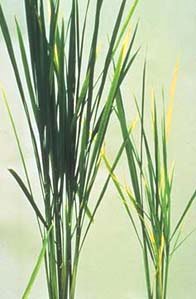
Normal / Deficient
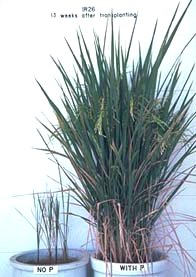
P deficiency in field
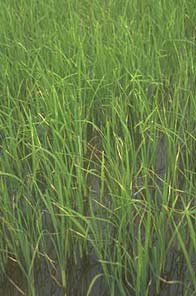
Figures 2.8 – 2.10: P deficiency symptoms
2.7.1 Recommended P rates and application timing
A rice crop will remove 0.35 kg of P2O5 per 50 kg rice per hectare. To account for this loss a crop removal, factor is included for soils testing 35-60 kg/ha of P.
Phosphorus is best applied pre-plant or pre-flood at rates determined via soil tests and yield expectations.
When needed, phosphorus fertilizer should be soil applied when land is prepared for planting. It is recommended to apply all phosphorus before planting in both water-seeded and dry-seeded rice. If phosphorus fertilizers could not be applied pre-plant, they can be applied before establishing the permanent flood.
2.8 Potassium (K)
2.8.1 The role of K
Modern high-yielding rice varieties absorb potassium in greater quantities than any other essential nutrient. In farmers’ fields across Asia, total K uptake rates of a crop yielding 5 t/ha are in the range of 100 kg/ha, of which more than 80% are concentrated in the straw at maturity. (Dobermann and Fraihurst, 2000). For yields greater than 8 ton/ha, total K uptake may even exceed 200 kg/ha.
2.8.2 K uptake process throughout the rice life cycle
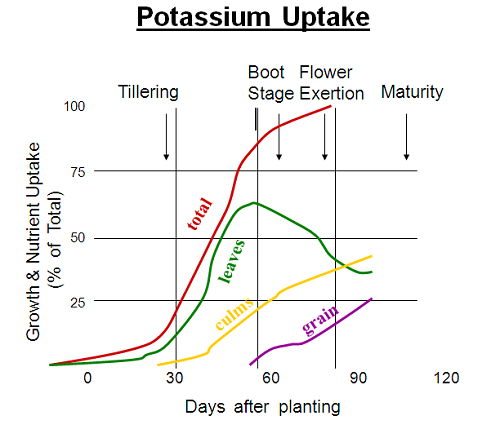
Figure 2.11: Potassium uptake process throughout the rice life cycle
Figure 2.11 shows that potassium is continuously taken up by the rice plant at a rate described by a sigmoidal curve, which gets to its maximum value during flowering. The potassium is firstly used for building the leaves biomass, then for the culms and later for the grains.
Proper potassium (K) nutrition in rice promotes:
- Tillering
- Panicle development (see Figures 2.12 – 2.14)
- Spikelet fertility
- Nutrient uptake of nitrogen and phosphorus
- Leaf area and leaf longevity
- Disease resistance
- Root elongation and thickness
- Culm (stem) thickness and strength
- Rice plant tolerance to diseases and pests
- Rice plant resistance to lodging
Recommended K rates are rarely sufficient to balance K removal rates under common commercial conditions. Therefore, most intensive rice production systems have been running under negative K balances and the negative effects of this have begun to emerge. The situation may be even more aggravated when all the straw is removed from the field with farmer practice in several countries. In some locations, the nutrients removed by crop are partly returned to the soil system in the form of farmyard manure (FYM).
Potassium deficiency occurs to a limited extent in lowland rice. Low potassium content or potassium deficiency is often associated with iron toxicity, which is common on acid latosolic soils and acid sulfate soils. Potassium deficiency also occurs on poorly drained soils, partly because toxic substances produced in highly reductive soils retard potassium uptake and partly because less soil potassium is released under poorly drained condition. The most important factors which determine the potassium balance of individual fields: soil characteristics, weather (climate), crops and cultural practices.
The yield of any grain crop depends on the number of ears per unit area, on the number of ripe grains per ear, and on the weight of the grain (frequently called "1000 grain weight"). Due to its influence on photosynthesis and assimilate transport, potassium is particularly effective in the improvement of grain number and grain weight. This has been confirmed in pot experiments and in numerous field trials with many cereal crops. See Figures 2.12 & 2.13.
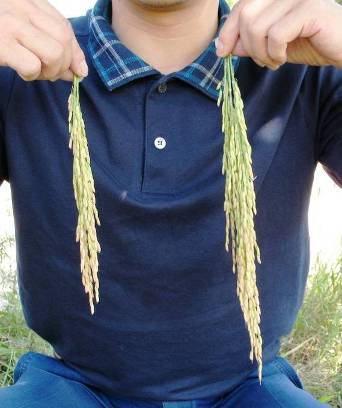
Figure 2.12: Effect of K on panicle size of rice, IPI-ISSAS project in Changsha, China. 9-2007. Source: IPI Coordination China
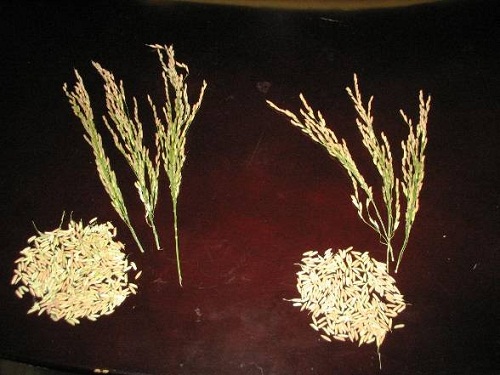
Figure 2.13: Effect of K on panicle size and number of grains per panicle. (The grains shown were harvested from three panicles.) IPI-ISSAS project in Changsha, China. 9-2007
Grain yield response per kg of K2O applied is higher in dry season than in wet season crop. In India, the following average responses have been recorded in commercial fields: 10 kg grain / kg K2O in dry season, and 8 kg grain / kg K2O in wet season.
Figure 2.14 shows two panicle samples and the grain removed from them, one taken from a plot not fertilized with K (left), and the other from a plot fertilized with K (right). Grains from each panicle were removed and categorized as: a) unfilled (top), b) partially filled (middle), and c) fully filled (top). Clearly, the sample from -K has a much larger proportion of unfilled and partially filled grain than does the sample from +K.
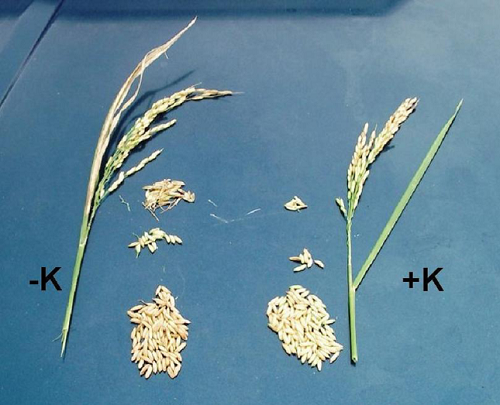
Figure 2.14: Effect of potassium on grain filling in rice.Source: R. Buresh at an SSNM field, 2006, Indonesia. e-ifc No. 16, June 2008
2.8.3 Rice response to K fertilization
Potassium fertilization field trialsincreased yields in 20 percent of the trial sites. The mean yield response was 10.6 kg rice per kg of K2O applied. The general lack of response to K application is attributed to high (greater than 250 ppm) soil exchangeable K content of the rice-growing soils.
Only about 10-20% of the total K taken up by the plant is removed in the grain. An average rice yield of 7,567 kg/ha (150 bushels per acre) will only remove approximately 22 kg/ha of K, which is equivalent to about 27 kg/ha of K2O. A mature rice crop, including grain and straw (all above-ground biomass), may weigh 6,800 to 9,000 kg/ha (dry weight) and contain on average 235 kg/ha K. Thus, total crop uptake at this yield level is 284 kg/ha of K2O.
Proper potassium (K) nutrition is critical for maximizing rice grain yields. K is very mobile within the rice plant. Studies have shown that supplemental K can be supplied to the rice plant as late as Internode Elongation (IE) and still increase rice grain yields. Whole plant K analysis at IE was better correlated to yield than flag leaf analysis at early boot.
The application of sufficient fertilizer K to overcome deficiency of K can increase the efficiency use of N fertilizer. Figure 2.15 illustrates a situation where the rate of N fertilizer application (120 kg/ha was sufficient with adequate application of fertilizer P and K to achieve a rice yield of 5.7 t/ha. With insufficient K fertilizer the yield was 5.2- 5.4 t/ha only. The application of additional K fertilizer, through an increase in yield with no additional application of N fertilizer, increased the recovery efficiency of the N fertilizer by the rice crop to 37% of the applied N fertilizer.
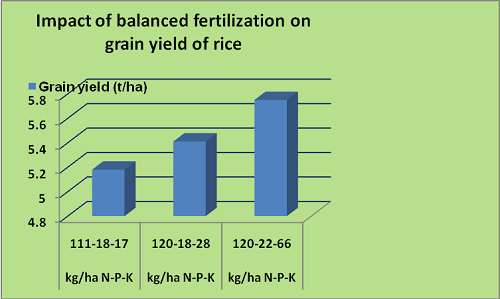
2.8.3.1 K reduces lodging
Foliar feeding has been shown (Better Crops, Vol. 89, 2005, #1) to markedly reduce lodging rates. Experiments were carried out by the University of Missouri, at the Delta Research Center. Two foliar applications of 30 kg/ha (34 lb/A) each, of potassium nitrate at midseason significantly reduced lodging (Figure 2.16), while MOP (potassium chloride) that was base- dressed pre-planting, or top-dressed at mid-season have not changed lodging rates.
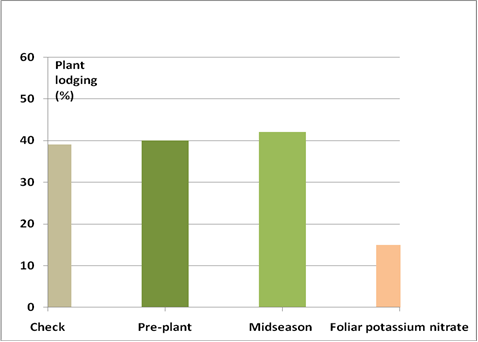
Figure 2.16: Reduced lodging of Baldo rice plants as a response to two foliar sprays of potassium nitrate at 30 kg/ha each
2.8.3.2 Lowland rice response to K fertilization and its effect on N and P
Potassium is absorbed in great quantities by rice, especially by high yielding cultivars, more than any other essential nutrient. Potassium fertilization at 70 and 100 kg/ha of K2O significantly increases panicle development and yield.
|
N |
P |
K |
S |
|
(kg/ha) |
|||
|
218 |
31 |
258 |
9 |
A single lowland rice crop produces 9.8 t/ha of grain in about 115-day uptakes.
2.8.4 K deficiency symptoms
Potassium deficiency symptoms include stunted plants with little or no reduction in tillering, droopy and dark green upper leaves, yellowing of the interveinal areas of the lower leaves, starting from the leaf tips, and eventually join together across the entire leaf and turn brown on all leaves (Figures 2.17 – 2.21).
The deficiency symptoms generally begin to appear near midseason and may be first observed when the plants do not “green up” after midseason N applications. As the deficiency progresses, the plants may develop severe disease infestation due to the plants’ reduced ability to resist infection. Diseases that are normally insignificant, such as brown leaf spot and stem rot may become severe in addition to diseases such as rice blast. While these diseases are typically more severe in K-deficient areas, they are not, by themselves, indications of K deficiency. Potassium is highly mobile in the plant, and deficiency symptoms will always occur first and be most severe on the oldest leaves. Older leaves are scavenged for the K needed by younger leaves. Rice leaf tips of the upper leaves often turn yellow and then brown during hot dry periods, however, these symptoms should not be confused with K deficiency.
Potassium deficiency is also noted by decreased culm thickness,
K deficiency increases incidence of and physiological disorders. Poor root oxidation potential causes decreased resistance to toxic substances produced under anaerobic soil conditions, e.g., Fe toxicity. Typical diseases aggravated under K deficiency are: brown leaf spot (caused by Helminthosporium oryzae), cercospora leaf spot (caused by Cercospora spp.), bacterial leaf blight (caused by Xanthomonas oryzae), sheath blight (caused by Rhizoctonia solani), sheath rot (caused by Sarocladium oryzae), stem rot (caused by Helminthosporium sigmoideum), and blast (caused by Pyricularia oryzae) where excessive N fertilizer and insufficient K fertilizer have been used.
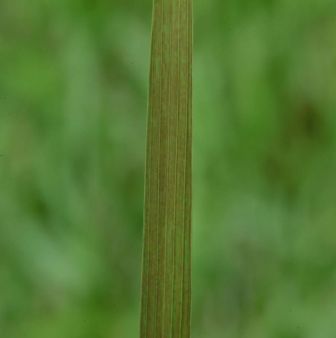
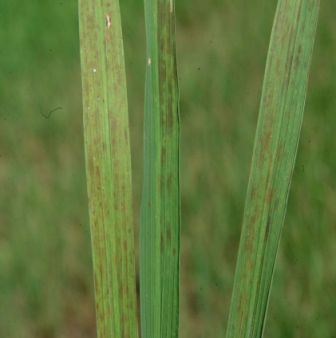
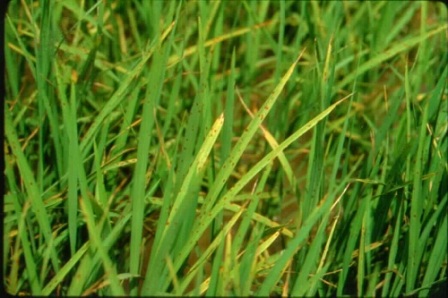
Figures 2.17 – 2.19: Rice K deficiency symptoms as shown on the leaves
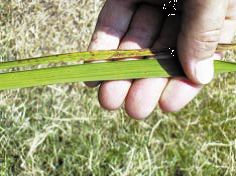
Figure 2.20: Potassium deficient leaf (top) compared to healthy leaf (bottom). Note the severe brown spot and yellow/brown leaf margins of K deficient leaf.
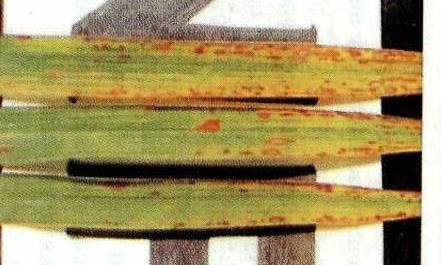
Figure 2.21: Typical deficiency symptoms of potassium (deficiency (rusty-brown spots, yellowing of the leaf tips and marginal necrosis) on the leaves of rice plants (variety IR 26).
Source: Bulletin 3, 1993, IPI, Horgen, Switzerland
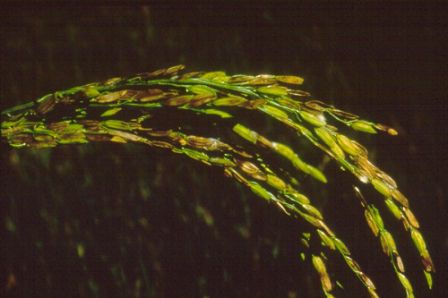
Figure 2.22: Typical potassium deficiency symptoms as manifested in a rice panicle
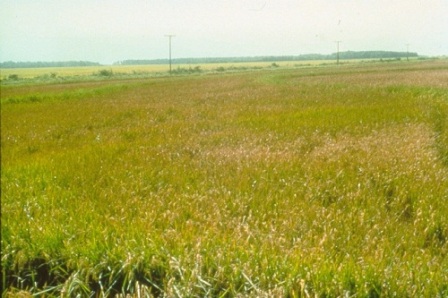
Figure 2.23: Typical potassium deficiency symptoms as manifested in a rice field
2.9 K fertilization requirements, timing and methods
The rice plant requires about 40 kg/ha K2O just to achieve a plant that can produce a yield target of 6.5 t/ha in the wet season, and 25 kg/ha K2O to attain a plant that can produce a yield of 5.5 t/ha in the dry season.
Additionally, the optimal nutritional balance is achieved with an uptake of 14.7 kg N, 2.6 kg P and 14.5 kg K per ton of grain yield.
Therefore, the total K2O requirements for a crop of 6.5 t/ha in the wet season, and a crop of 5.5 t/ha in the dry season, are 153 (40 + 6.5 * 14.5 * 1.2) and 121 (25 + 5.5 * 14.5 * 1.2) kg/ha, respectively.
Potassium application is recommended based on soil test results, before rice shows K deficiency symptoms during the season, as only low yield benefit, if any, is obtained from K fertilizer application to deficient rice in the mid-to-late boot stage. K fertilizer added at this time probably has little benefit for the current rice crop, but will remain in the soil for the future crops.
Silt and sandy loam soils have a very low buffering capacity and soil test K can decline rapidly if K fertilizer is omitted for several consecutive crops.
Although broadcasting and incorporating the whole K application at the time before planting or pre-flood is generally recommended, split application is also common in some areas. When needed, potassium fertilizer should be soil applied when land is prepared for planting. It is recommended to apply all potassium before planting in both water-seeded and dry-seeded rice. If potassium fertilizers could not be applied pre-plant, they can be applied before establishing the permanent flood.
2.10 Effects of N, P and K on rice yield
As mentioned already, the optimal nutritional balance is achieved with an uptake of 14.7 kg N, 2.6 kg P and 14.5 kg K per ton of grain yield.
Results for 21 consecutive cropping seasons (during 10.5 years of intensive cropping in 1995 to 2005) indicate that with balanced fertilization of N, P, and K, grain yield averaged 5.5 t/ha in the dry season and 6.5 t/ha in the wet season. The accumulated loss in grain yield without application of N fertilizer was 40 t/ha (Figure 2.25). This corresponds to an average grain yield loss of 2 t/ha in each season if N fertilizer was not used. Thus, the use of N fertilizer with appropriate amounts of fertilizer P and K ensured an average additional grain yields of 2 t/ha in each season.
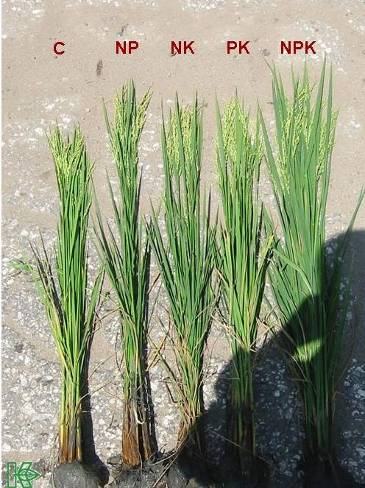
Figure 2.24: Effect of N, P and K on rice plant size. IPI-SWRI project in the Nile Delta, Egypt. 2006. Source: IPI Coordination WANA
The corresponding figures for potassium were 10 t/ha yield loss for the experiment period, which mean a 1/2 t/ha yield loss for each season if K fertilizer was not applied.
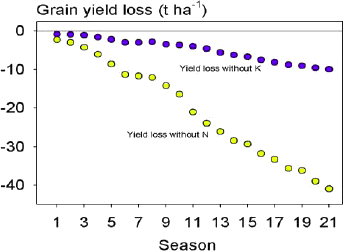
Figure 2.25: Loss in rice grain yield after 21 successive crops when nitrogen and potassium fertilizers are not applied. (Long Term Fertility Experiment, Sukamandi Experiment Station, Indonesia)
2.11 Secondary plant nutrients
Sulfur plays an important role in the biochemistry and physiology of the rice plant, mainly in chlorophyll production, protein synthesis, and carbohydrate metabolism. S deficiency has been reported from Bangladesh, Burma, Brazil, Indonesia, India, Nigeria, Philippines and Thailand. Symptoms of S deficiency are very similar to N deficiency symptoms, producing pale yellow plants which grow slowly. However, the main difference is that sulfur is immobile in the plant; therefore, the yellowing will first appear in new leaves rather than older leaves.
Most soil sulfur is contained in the soil organic matter. Sulfur deficiencies will frequently occur in the cut and deep-fill areas of newly land-formed fields. In such cases, sulfur deficiencies can usually be avoided by applying a minimum of 112 kg/ha of ammonium sulfate (NH4)2SO4, between preplant and the 2-3 leaf plant stage. This treatment will provide 23 kg/ha of nitrogen and 26 kg/ha of sulfur.
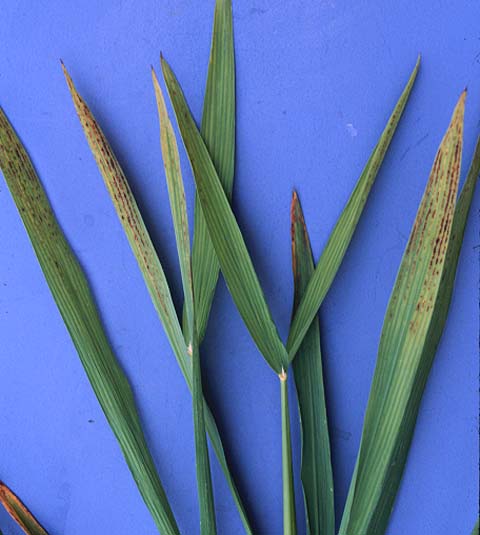
Figure 2.26: Symptoms of sulfur deficiency on a rice plant
In Bangladesh, 20 kg/ha S is generally recommended in the form of gypsum for dry season rice, the residual effect of which can often meet the S requirement of the succeeding wet season rice crop. In Bangladesh, application of S along with NPK increases the grain yield by 30-79 % above that obtained by using NPK fertilizers alone. In India, although S is yet to be introduced to the regular fertilizer schedule for rice, researchers have suggested application of 30 kg/ha S per crop at Delhi and 44 kg/ha S per two crops at Bhubaneswar, Orissa. In general, application of S-containing fertilizers is advocated during the final land preparation.
2.11.2 Calcium (Ca)
Calcium is important for the build-up and functioning of cell membranes and the strength of cell walls. Most calcium-related disorders of crops are caused by unfavorable growing conditions and not by inadequate supply of calcium to the roots. Rapidly growing crops in hot windy conditions are most at risk. Deficiencies can also develop under waterlogging, soil salinity, high potassium or ammonium supply, and root disease.
Calcium moves in the plants' transpiration stream and is deposited mainly in the older leaves. Deficiencies are found in the youngest leaves and growing points, which have low rates of transpiration. Youngest emerging leaves show the following symptoms only under severe Ca deficiency:
- Interveinal chlorosis (Figure 2.27) and leaf may bend downwards because the leaf margins have failed to expand fully (Figure 2.28).
- White or bleached, rolled, and curled tips of leaves
- Necrosis along the lateral margins of leaves
- Stunting and death of growing points
- Mature and older leaves are generally unaffected, but in severe situations old leaves turn brown and die too.
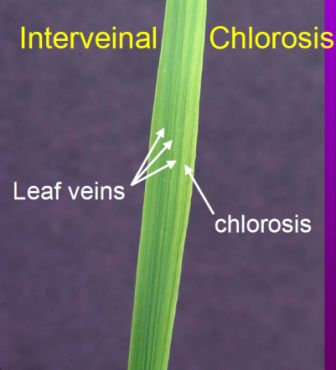
Figure 2.27: Interveinal chlorosis in calcium deficient rice leaves
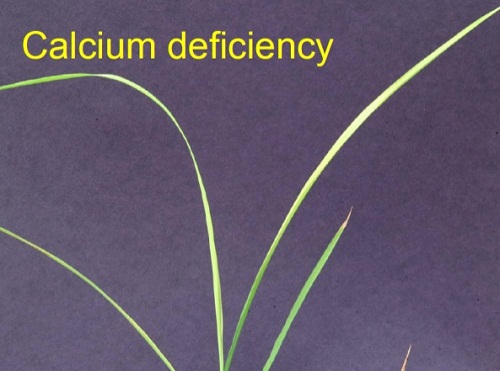
Figure 2.28: Downward bending in calcium deficient rice leaves
Importance / Occurrence:
- Relatively rare in irrigated rice systems.
- Common in acid, strongly leached, low-CEC soils in uplands and lowlands, soils derived from serpentine rocks, coarse-textured sandy soils with high percolation rates and leaching, and leached old acid sulfate soils with low base content.
- Important throughout the growth cycle of the rice crop.
2.12 Micronutrients (trace elements)
Micronutrient deficiencies typically do not occur on acid to slightly acid clay soils (pH = 5-6.5). However, silt and sandy loam soils, as well as any high-pH soils (>7.5), are subject to various micronutrients deficiencies. Soils with high available P and low organic matter are also subject to Zn deficiency.
2.12.1 Zinc (Zn)
2.12.1.1 Role of Zn
In plants, Zn is critical for many physiological functions, including the maintenance of structural and functional integrity of biological membranes and the facilitation of protein synthesis. Of all micronutrients, Zn is required by the largest number of enzymes and proteins. The zinc pathways have important roles in:
- Photosynthesis and sugar formation
- Protein synthesis
- Fertility and seed production
- Growth regulation
- Defense against disease.
2.12.1.2 Differentiating Zn deficiency from salinity and P deficiency
Zinc deficiency, P deficiency and salinity injury symptoms are easily and often confused. Zinc deficiency symptoms usually occur after flushing or flooding, whereas problems from salinity occur prior to flushing or flooding under dry soil conditions. Both salinity and Zn deficiency can be present in the same field. Phosphorus deficiency is also similar to Zn deficiency in that the symptoms typically occur after flooding. However, leaves are usually more erect and basal chlorosis (yellowing) is usually not present with P deficiency. Also, Zn deficiency appears much sooner after the flood is established, usually within a few days, whereas it generally takes a week or two after flooding to show P deficiency.
Rice is particularly susceptible to Zn deficiency, as it grows in waterlogged soils which are conducive to zinc deficiency. Flooding the soil reduces Zn availability to the crop and increases the concentrations of soluble P and bicarbonate ions, which can exacerbate problems of Zn deficiency. Symptoms are more severe in cold-water areas and where theflood is the deepest.
Visual symptoms, field history and soil pH and soil Zn determination are important methods for determining if Zn fertilizer may be needed. But, plant tissue analysis is the most effective means of correctly distinguishing which nutrient is the cause of the unhealthy rice.
2.12.1.3 Zn deficiency symptoms
The symptoms are often noted within 72 hours after flooding and are aggravated by deep and cold water. When they become severe enough, the flood must be removed in order to salvage the rice. If the soil pH is extremely high, deficiency symptoms may appear after a flush or a rain.
Environmental factors, such as cool temperatures, may increase the severity of deficiency symptoms. Likewise, excessive P fertilizer applications may aggravate a Zn deficiency. Prior to flooding, the symptoms are usually subtle and difficult to observe without very close visual examination. Seedling rice can obtain sufficient nutrients from the seed for about 10 days after emergence. Therefore, Zn deficiency symptoms do not generally appear in seedling rice until at least 10 days after emergence, and it may take several weeks after emergence for the symptoms to appear.
The Zn deficiency symptoms, whether subtle if observed before flooding or severe if observed after flooding, include:
- Basal leaf interveinal chlorosis – the portion of the leaf nearest the stem becomes light green while the leaf tip remains a darker green. Usually begins in the youngest leaf (Figure 2.29).
- Pale-green color on the bottom half of the leaves 2 to 4 days after flooding;
- Leaves become yellowish and start dying 3 to 7 days after flooding.
- 4. Abnormally-shaped leaves and leaf stunting.
- Leaves may lose turgidity and tend to float on the water surface if the rice is flooded or being flushed. Flushing seedling rice can aggravate Zn deficiency, causing the visual symptoms mentioned to become more noticeable and enable visual diagnosis before flooding to avoid a salvage situation. So pay close attention to the young rice when flushing. The loss of leaf turgidity is a difficult symptom to evaluate since deep water may give leaf tissue a similar appearance.
- Bronzing – consists of brown to red splotches starting on the surfaces of the oldest leaves. Bronzed leaf tissue may eventually turn brown. A bronzed appearance of the plants, and when closely examined the leaves often show an irregular rusty pattern; Bronzing normally follows basal leaf chlorosis.
- Stacking of leaf sheaths or joints.
- Stunting/reduced height.
2.12.1.4 Zn deficiency during crop development
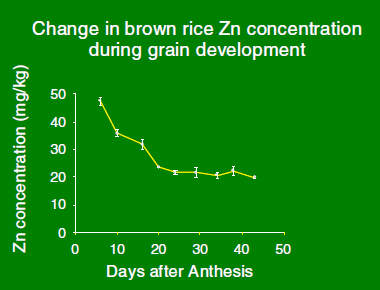
Figure 2.30: Change in brown rice Zn concentration during grain development
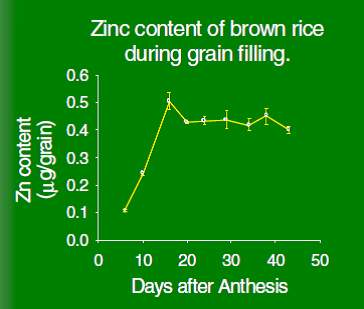
Figure 2.31: Zinc content in brown rice during
grain filling
2.12.1.5 Effect of soil type on Zn deficiency
Zn deficiency is the most widespread micronutrient disorder in lowland rice and high-pH soils frequently require the addition of zinc for rice production.
Zinc deficiency normally occurs on silt and sandy loam soils or on precision graded fields. It is caused by a reduction in the availability of native soil Zn because the soil pH has been increased either by use of calcareous irrigation water or over-liming, not due to a lack of Zn in the soil. The correction of the problem requires either reduction of the soil pH or addition of a suitable Zn source. Zinc deficiency is not commonly observed on clay soils in Arkansas. Therefore, Zn fertilizer is only recommended on silt and sandy loam soils with soil pH greater than 5.9 and soil test Zn (Mehlich 3) 7 pounds Zn per acre. Fields with high pH (>7.5) clay soils should be monitored carefully since Zn deficiency on clay soils is known to occur in many rice producing areas of the world.
2.12.1.6 Time and method of Zn application
If using soil-applied zinc in water-seeded rice, application of zinc should be just before flooding or with zinc sulfate.
If a soil test indicates a Zn deficiency prior to planting, broadcast-apply 8-11 kg/ha of Zn, in the form of 22-34 kg/ha (20-30 pounds/acre) of Zinc Sulfate. It can be applied this way starting before planting or into the water soon after flooding. Since rice roots develop near the soil surface, and seedling root growth is slow in the water-seeded system, it is important that most of the zinc will be on or near the soil surface. In the dry-seeded system, soil-applied zinc should be broadcast and shallow incorporated no more than 2.5-5 cm deep. Initial root development in the dry-seeded system is beneath the soil surface, and soil incorporated zinc is more available. Non-incorporated zinc should be located above the rooting zone in dry seeded rice.
If deficiency symptoms occur after rice emergence, apply a zinc chelate at 0.5-1 kg/ha as a foliar spray. Zinc chelate can be tank-mixed with propanil if the propanil is needed for weed control.
On alluvial soils with a neutral – slightly alkaline soil reaction, soil-applied zinc can be made unavailable by the soil. If zinc deficiency is a problem in these soils, foliar treatment or soil + a foliar treatment may be preferable to a soil treatment alone. If zinc deficiencies are observed, apply foliar sprays quickly.
Alternative recommendations:
- Root dipping of seedlings in 1-4 % ZnO suspension before transplanting.
- Foliar spraying of 1 - 3 % Haifa Bonus+Zn solution at 30, 45 and 60 days after planting or more frequently.
Zn along with NPK fertilizer increases the grain yield dramatically in most cases, see Table 2.13.
Table 2.13: Response of lowland rice to Zn application
|
Country |
Soil characteristics |
Zn application rate (kg/ha) |
Grain yield increment (t/ha) |
|
India |
Calcareous red, pH 7.5 Saline-alkali, pH 10.6 Aquic Camborthid |
10 10 11.2 |
1.8 1.0 1.4 |
|
Pakistan |
Calcareous |
100 |
2.6 |
|
Philippines |
Calcareous Hydrosol |
10 Root dipping in 2 % ZnO |
4.8 4.4 |
|
Thailand |
|
15 |
0.4 |
|
USA |
Norman clay Crowley silt loam Crowley silt loam |
9 27 8 |
7.0 (!) 0.7 2.4 |
Source: Jones et al., 1982
2.12.2 Boron (B)
Boron main functions in rice (and all other plants) are:
- Takes an important part in cell-wall biosynthesis
- Affects structure and plasma membranes integrity.
- Boron deficiency symptoms in rice are:
- White and rolled leaf tips of young leaves
- Reduction in plant height
- Tips of emerging leaves are white and rolled (as in Ca deficiency)
- Death of growing points, but new tillers continue to emerge during severe deficiency
- If affected by B deficiency at the panicle formation stage, plants are unable to produce panicles
Boron deficiency correction methods
Optimum preplant B contents for some soils is 0.25-0.5 kg/ha, which corresponds with a critical level for hot-water extractable boron of 0.25-0.35 ppm.
In order to achieve this contents rate, a broadcast application of 0.75 kg/ha of pure boron is advocated. This can be achieved by application of 6.8 kg/ha of commercial Borax, (Na2B4O7 .10H2O, containing 11% pure B), or 4.3 kg/ha of commercial boric acid (H3BO3, containing 17.5% pure B).
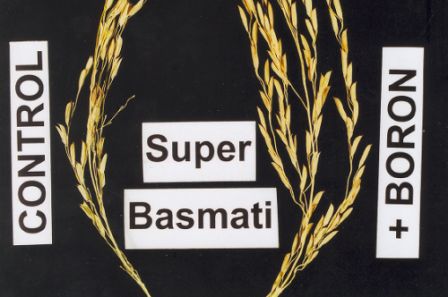
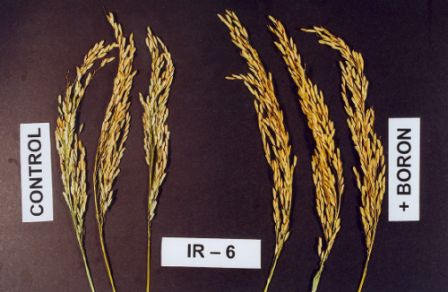
Figure 2.32: The corrective effect of applying Borax at 1.0 kg/ha of pure boron, on Super Basmati and IR-6 rice cultivars. Source: A. Rashid et al. NARC, Islamabad, Pakistan, 2005
Rice yields increase by more than 500 kg/ha with 0.5-1.0 kg/ha added boron fertilizer, such as "Borax."
Figure 2.33: The corrective effect of applying Borax at 0.5-1.5 kg/ha of pure boron, on IR-6 rice cultivar.(Source: A. Rashid et al. NARC, Islamabad, Pakistan, 2005)
2.12.3 Iron (Fe)
2.12.3.1 Fe Deficiency symptoms
The symptoms of iron deficiency are yellowing or chlorosis of the interveinal areas of the emerging leaf (Figure 2.34). Later the entire leaf turns yellow, and finally turns white. If the deficiency is severe, the entire plant becomes chlorotic and dies. Iron deficiency can easily be mistaken for nitrogen deficiency. However, nitrogen deficiency affects the older leaves first, while iron deficiency affects the emerging leaves first.
2.12.3.2 Soil conditions likely to produce Fe deficiency in rice
The iron requirement of rice is greater than that of other plants. Iron deficiency is a common disorder of rice growing on well-drained (aerobic) soils, whether these are neutral, calcareous or alkaline. The severity of the disorder increases with the pH. Iron deficiency may also be observed in rice on upland acid soils.
In flooded rice paddies, iron deficiency is likely to be found in calcareous and alkaline soils low in organic matter, and in soils irrigated with alkaline water.
Iron deficiency may also be a problem in peat soils, especially if these are well-drained, and with a high pH.
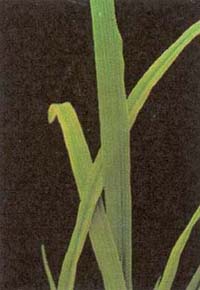
Figure 2.34: Iron deficiency symptoms
2.12.3.3 Diagnosis by soil analysis
Well-drained soils with a pH>6.5 are likely to be deficient in available iron. The severity of the problem increases with a high pH.
In flooded rice soils, iron deficiency may occur if the redox potential of the soil at a pH of 7 is more than 0.2 volt. In this situation, the total soil iron content may be high, but the level of available iron in the soil remains low.
Iron deficiency is likely to be observed if the iron concentration in the soil is:
- Less than 2 mg/kg, extracted by ammonium acetate, with a pH= 4.8.
- Less than 4-5 mg/kg, extracted by DTPA-Calcium chloride, with a pH= 7.3.
- Diagnosis by plant analysis: the critical level for iron deficiency in rice is 50 mg/kg, in shoots sampled from the stages of tillering to panicle initiation.
2.12.3.4 Interaction with other elements
A high concentration of calcium carbonate in the soil or irrigation water is likely to make iron deficiency of rice more severe. Iron deficiency can sometimes be caused by too much nitrate, which raises the pH of the soil around the roots. High phosphate applications may cause iron deficiency, or make it worse, by precipitating iron in the soil solution. High phosphate levels may also hinder the uptake of iron by plants, and the translocation of iron from the root system to the shoots.
2.12.3.5 How to correct Fe deficiency in rice
Iron deficiency can be amended by applying a foliar spray of 2-3% ferrous sulfate (FeSO4) solution. Another way of correcting the deficiency is to apply about 30 kg/ha of iron as ferrous sulfate to the soil. Because of the low mobility of iron in the plant, split applications may be necessary.
2.12.4 Manganese (Mn) toxicity of rice
Source: Corinta Quijano-Guerta, International Rice Research Institute, Philippines
2.12.4.1 Mn toxicity symptoms
Visual symptoms of manganese toxicity in rice appear as brown spots on older leaves (Figure 2.35). About eight weeks after planting the tips of leaves dry out. Vegetative growth is not appreciably affected, but grain yield is markedly depressed because of high sterility.
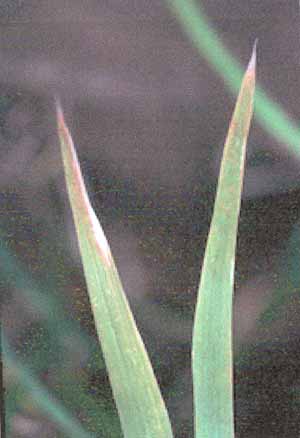
Figure 2.35: Typical symptomsof manganese toxicity in rice
2.12.4.2 Soil conditions conducive to Mn toxicity
Manganese toxicity is sometimes observed in dryland rice with soilpH 5.5.
It rarely occurs in lowland paddy soils, but may occur if the soil contains very large amounts of easily reducible manganese, or in areas contaminated by manganese mining.
2.12.4.3 Diagnosis by soil analysis
The toxicity is probably related to the concentration of easily reducible manganese in the soil, but no critical level is known. An aqueous soil solution with a manganese level of more than 2 mg/L is considered toxic.
2.12.4.4 Diagnosis by plant analysis
Critical limits:
|
Plant organ checked |
Physiological stage |
Value (mg/kg DW) |
|
Shoot |
Tillering |
7,000 |
|
Leaves |
Flowering |
3,000 |
2.12.4.5 Interaction with other elements
The solubility of manganese increases sharply in aerobic soils as the pH drops below 4.5, while that of iron hardly changes until the pH is down to 2.7-3.0. This fall in pH increases the ratio of manganese to iron, leading to manganese toxicity.
However, it does not follow that manganese toxicity induces iron deficiency, or vice versa.
Silica has been reported to alleviate manganese toxicity by decreasing the uptake of manganese, and by increasing the internal tolerance to manganese in the plant tissue. Manganese toxicity is usually accompanied by aluminum toxicity and phosphorus deficiency.
2.12.4.6 How to correct Mn toxicity
Liming is a common remedy for manganese toxicity. The application of ferrous sulfate (FeSO4), gypsum and farmyard manure can also be helpful, as can be application of silica slag at a rate of 1.5 to 3 mt/ha. NPK fertilizer is often needed, but acidifying nitrogen sources should not be used.
2.12.5 Aluminum (Al) toxicity of rice
Source: Corinta Quijano-Guerta, International Rice Research Institute, Philippines
2.12.5.1 Description of symptoms
Rice suffering from aluminum toxicity shows interveinal white to yellow discoloration of the tips of older leaves, which may later turn necrotic (Figure 2.36). The roots of affected plants are stunted and deformed.
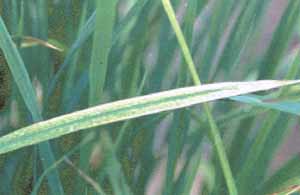
Figure 2.36: Typical white discoloration of aluminum toxicity in rice leaves
2.12.5.2 Soil conditions likely to produce aluminum toxicity
Aluminum toxicity commonly occurs in Oxisols and Ultisols as well as in other heavily leached soils such as lateritic soils of the humid tropics. It is an important growth limiting factor on upland soils with a pH 5.
Aluminum toxicity in wetland rice is observed in most acid sulfate soils during the initial phase of soil flooding. The rise in pH of acid sulfate soils after submergence is very slow, so that toxicity may persist for many weeks.
Diagnosis by soil analysis
A soil pH 4, and an aluminum concentration in the soil solution of more than 1 mg/L, indicate toxic levels of aluminum.
Diagnosis by plant analysis
An aluminum concentration over 300 mg/kg in the shoot at the tillering stage is generally considered toxic.
2.12.5.3 Interaction with other elements
Aluminum toxicity in upland rice is always associated with manganese toxicity and phosphorus deficiency. Aluminum toxicity hinders the uptake by rice of phosphorus, calcium and potassium (Figure 2.37).
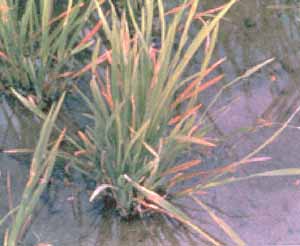
Figure 2.37: Leaves symptoms from combined manganese and aluminum toxicities under severely acidic soil
2.12.5.4 How to correct Al toxicity
Liming will increase the soil pH. Growers should use dolomitic lime, if possible. It is necessary to apply phosphorus and potassium fertilizers. Acidifying nitrogen sources should be avoided.
Other cultivation practices
Early plowing is recommended, right after the recession of floods at the end of the rainy season. Acid sulfate soils should have a shallow drainage system.
The rice should be planted after prolonged soil submergence, and growers should select rice varieties with tolerance to aluminum toxicity.
Need more information about growing rice? You can always return to the rice fertilizer & crop rice and cultivation



